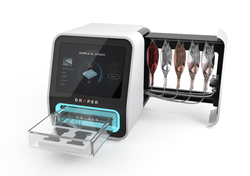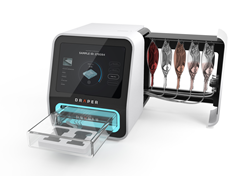
Draper secured an FDA contract to develop a system for acoustic cell separation. Pictured is a device concept. Credit: Draper.
“There is tremendous need for additional therapeutic options for patients with certain cancers and rare diseases, such as sickle cell disease, and we look forward to cooperating with FDA on developing the acoustophoresis device,” said Tara Clark, Vice President of Commercial Business at Draper.
CAMBRIDGE, Mass. (PRWEB)
July 23, 2020
The U.S. Food and Drug Administration has awarded Draper a $2.19 million, three-year contract, through a competitive mechanism, to develop a manufacturing instrument that could help usher in a new wave of cell therapies. The impact could be huge for the millions of people living with cancer or diseases with no known cures, and provide cell therapy manufacturers the technology necessary to produce at the scale required to treat all of these patients.
Under the contract, the FDA will sponsor development of a system designed to enable microfluidic acoustic cell separation and continuous, label-free purification for both autologous and allogeneic cell therapy production.
Companies that manufacture cell therapies could see other benefits to using the new platform when it is complete, including high volume production, low-cost disposable components and greater flexibility to work with a variety of cell types or process flows, according to Jason Fiering, Principal Investigator at Draper.
“One of our goals is to advance the technology by constructing demonstration units, ready for commercial testing,” says Fiering. “These instruments will enable cell therapy manufacturers to produce allogeneic cell therapies much as vaccines are produced: doses are prepared in advance and can apply to a large number of patients with a specific health condition.”
Fiering works on a team at Draper that specializes in an area of biomedical engineering that uses new kinds of materials, protocols and tools to improve cell separation and purification. The system under development at Draper uses ultrasonics instead of centrifuges, filters or magnetic beads to separate and purify various populations of cells, which may come from a bioreactor or directly from a patient.
“Microfluidic acoustic separation (or acoustophoresis) is gentle on cells, has high selectivity that responds to cell size, density and compressibility and can exceed the capabilities of centrifugation or filtration,” said Fiering. “The system’s design allows it to operate without the need for antibody-based reagents or other features that escalate manufacturing cost.”
Draper is aiming to expand the disposable plastic cartridge, approximately the size of a cell phone, and achieve production rates of one liter an hour—a milestone in cell therapy manufacturing.
“The funding of the acoustophoresis device represents an important milestone for cell therapy production, and for Draper,” said Tara Clark, Vice President of Commercial Business at Draper. “There is tremendous need for additional therapeutic options for patients with certain cancers and rare diseases, such as sickle cell disease, and we look forward to cooperating with FDA on developing the acoustophoresis device.”
The microfluidic acoustic cell separation system is part of an integrated portfolio of technologies and resources at Draper intended to help government, industry and academia make better use of biomedicine. The company is working with pharmaceutical companies on drug discovery and development and biomanufacturing companies on increasing the speed and reducing the cost of processing cell therapies.
Draper
At Draper, we believe exciting things happen when new capabilities are imagined and created. Whether formulating a concept and developing each component to achieve a field-ready prototype or combining existing technologies in new ways, Draper engineers apply multidisciplinary approaches that deliver new capabilities to customers. As a not-for-profit engineering innovation company, Draper focuses on the design, development and deployment of advanced technological solutions for the world’s most challenging and important problems. We provide engineering solutions directly to government, industry and academia; work on teams as prime contractor or subcontractor; and participate as a collaborator in consortia. We provide unbiased assessments of technology or systems designed or recommended by other organizations—custom designed, as well as commercial-off-the-shelf.
Share article on social media or email:

